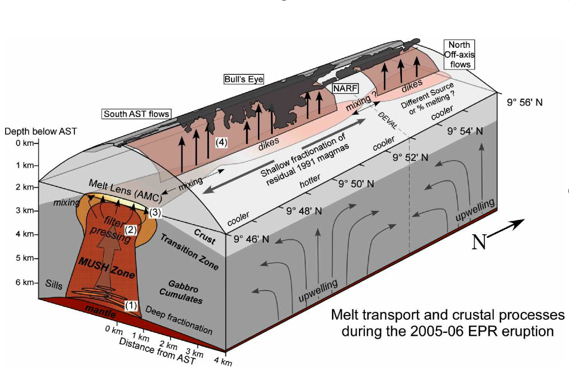Perfit
M. Perfit, Dept. of Geological Sciences, University of Florida
We now have excellent geochemical data from spatially related collections of mid-ocean ridge basalts (MORB) and back-arc basin basalts (BAB) as well as their related differentiates (basaltic andesites, andesites and dacites) from the three Integrated Study Sites (ISS). In addition, significant geophysical, hydrothermal and biological data from these sites are now available. Volcanic units have a much larger range of compositions and flow morphologies than previously thought, hydrothermal cells have been mapped with microseismicity, seismic images show ridge segmentation more clearly and substantiate there are regions of melt away from ridge axes. At the EPR ISS, the first repeat eruption on a MOR has allowed us to evaluate how a ridge erupts and what the effects are on a decadal scale. Detailed ISS studies have provided a rich spatial and temporal view of ridge processes.
Although we have learned much from our detailed observations, the physical and chemical processes associated with mantle melting, transit of melt trough the lithosphere and eruption on the seafloor are incompletely understood. At this point it is imperative for us to focus on synthesizing and integrating our various observations and data sets in order to gain a better understanding of the causal links between observed geological, geochemical, hydrothermal and biological processes associated with MOR and Back Arc crustal accretion. Now is the time for us to relate both the timing and character of ridge volcanic and tectonic events to variations in the ridge crest structure, topography, magmatic plumbing, hydrothermal plume and vent-fluid chemistry, and vent-biological community structure at a variety of segment scales. Each of us has pieces of the ridge puzzle that we have carefully developed but how do we put them together? Are there any critical pieces missing? How can we facilitate the collaboration needed to put all the pieces together to see the “big picture”?
One of the pieces that is missing at the ISS is a depth perspective – we have little to no idea of the structure and composition of the lower crust. Exposures of upper mantle and lower crust along spreading centers has led to new ideas about mantle melting, melt transport, rock-melt interactions and hydrothermal processes at depth - primarily at slow and ultraslow ridges. Additionally, successes in deep drilling of ocean crust away from volcanically and hydrothermally active spreading centers have confirmed the linkages between hydrothermal activity and magmatism, and have extended our view of the magmatic processes in the lower crust and their thermal and chemical effects on the upper crust. Can these observations be used to give us a more complete picture of the ISS sites and visa versa; can ISS data help us to understand regions where the upper crustal variation is poorly known?
At this meeting we need to identify and help facilitate connections between research groups and individuals from different and overlapping disciplines in order for them to more easily collaborate on joint projects where data and ideas can be integrated. Funds should be made available for small groups to meet to begin this process that hopefully will start during this meeting.

